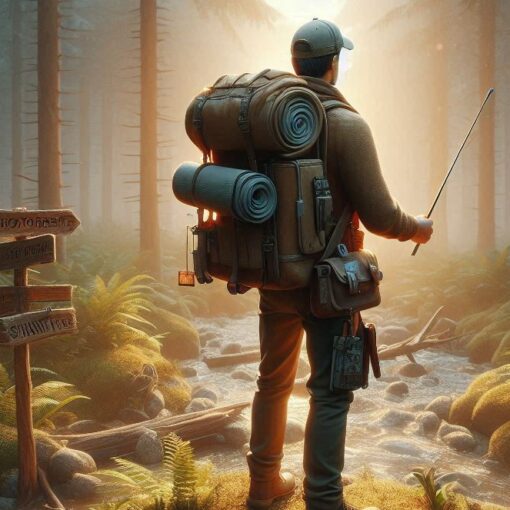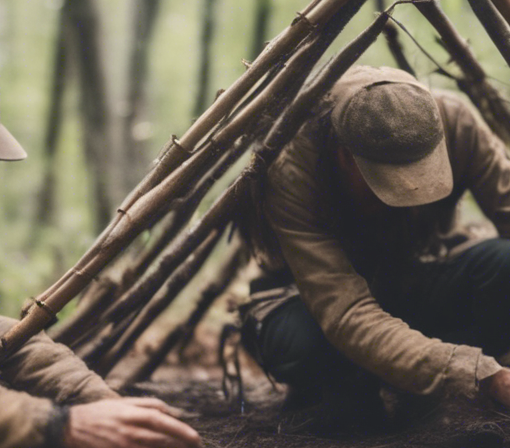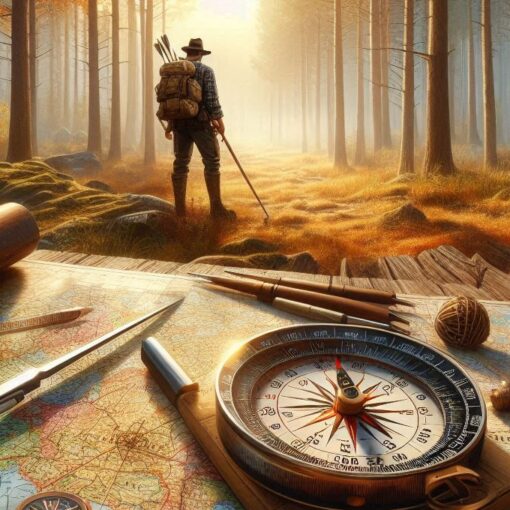 Let’s say that you have finally decided to venture into the wild. Maybe you’re fed up with the daily grind—those endless emails and Zoom meetings that make you feel like a hamster on a wheel—or perhaps you just binge-watched one too many episodes of “Survivor” and thought, “Hey, I could totally outwit, outplay, and outlast!” Well, good for you! Nothing screams adventure quite like trading your cozy couch for a patch of dirt and an overly ambitious squirrel.
Let’s say that you have finally decided to venture into the wild. Maybe you’re fed up with the daily grind—those endless emails and Zoom meetings that make you feel like a hamster on a wheel—or perhaps you just binge-watched one too many episodes of “Survivor” and thought, “Hey, I could totally outwit, outplay, and outlast!” Well, good for you! Nothing screams adventure quite like trading your cozy couch for a patch of dirt and an overly ambitious squirrel.
But before you go off channeling your inner Tarzan or Bear Grylls (minus the whole drinking-your-own-pee thing), let’s chat about some essential survival skills. You know, the kind that might prevent you from becoming bear bait or succumbing to a nasty case of giardiasis from that questionable water source that looks suspiciously like it was used as a raccoon swimming pool.
First off, let’s talk about bears. Yes, those furry behemoths that can run faster than your last relationship ended. Here’s a tip: if you encounter one in the wild—and please don’t ask it for directions—you’ll want to remember two things: Don’t run (because nothing says “snack” quite like fleeing prey) and make yourself look bigger.
Think about it; this is not unlike trying to impress someone at a bar by puffing out your chest while awkwardly attempting to dance. Just stand tall, wave your arms around like you’re trying to swat away invisible flies, and back away slowly while humming something soothing—preferably not “Eye of the Tiger.”
Now onto hydration! Water is crucial unless you’re planning on dehydrating faster than an old sponge left in the sun. But wait! Not all water is created equal. That crystal-clear stream may look inviting but could be hosting more bacteria than a college dorm during finals week.
If it smells funny or has floating bits (and not the good kind), do yourself a favor: find another source or invest in some purification tablets because trust me; nobody wants to spend their wilderness experience hugging a toilet—or worse!
And speaking of essentials, let’s discuss fire. Ah yes, fire—the ultimate mood setter for any camping trip unless you’re using it to roast marshmallows over what should have been your tent instead of turning it into an unintentional bonfire.
Building fire isn’t just about striking two sticks together like some sort of caveman Tinder date; it’s about knowing what materials work best without accidentally summoning Smokey Bear’s wrath.
You’ll need dry leaves, twigs—basically anything flammable except maybe your ex’s letters (though they might burn nicely). And once you’ve got that flickering flame going? Congratulations! You’ve unlocked one of humanity’s oldest achievements since someone discovered they could cook food instead of gnawing on raw meat like an overzealous Neanderthal.
Remember: GPS devices are fantastic until they decide to take a coffee break when you’re miles deep in nature’s embrace with no cell service whatsoever. So learn how to read those ancient scrolls we call maps; they won’t steer you wrong…unless you’re using them upside down—which I hear is less effective.
1. Finding Water: Because Dehydration Is a Real Killjoy
 First things first: you need water. Not just because you want to stay hydrated and healthy—that’s a nice little side benefit—but because without it, you’re going to be a goner faster than you can say “desert mirage.” Seriously, if your body were a car, water would be the gas. And we all know what happens when you run out of gas—spoiler alert: it involves sitting on the side of the road, contemplating life choices.
First things first: you need water. Not just because you want to stay hydrated and healthy—that’s a nice little side benefit—but because without it, you’re going to be a goner faster than you can say “desert mirage.” Seriously, if your body were a car, water would be the gas. And we all know what happens when you run out of gas—spoiler alert: it involves sitting on the side of the road, contemplating life choices.
Now, where do you find this precious elixir? Streams, rivers, and lakes are your obvious go-tos. They’re like the fast food joints of hydration—easy to spot and usually packed with options. But if you’re stuck in some barren wasteland where those are as scarce as a good plot twist in a reality show, don’t despair!
Look for dew on plants in the morning; it’s nature’s version of free samples at Costco. Or try digging a hole in a dry stream bed and pray it fills up with something drinkable. Just make sure that “something” isn’t more dirt or last week’s leftovers from an unfortunate picnic.
Now let’s talk about purifying that water. Just because it looks clear doesn’t mean it’s safe! Ever heard of giardia? It sounds like an exotic Italian dish but trust me—it’s not something you want to order off any menu unless your idea of fine dining includes endless trips to the bathroom. This microscopic monster will make you wish you’d stayed home binge-watching cat videos instead of gallivanting through the wilderness.
So how do you turn that questionable liquid into something that won’t have your stomach doing the cha-cha? First off, boil the water. Yes, I know—this sounds like something out of a survivalist manual written by someone who thinks camping is roughing it at a Holiday Inn. But boiling is effective! It kills most pathogens faster than my uncle at Thanksgiving dinner after one too many helpings of turkey.
If boiling isn’t your style—or if you’re trying to avoid turning your campfire into an accidental bonfire—you could use purification tablets. These little wonders are like magic pills for water; drop them in and voilà! You’ve got yourself something safer to drink than whatever’s lurking in that murky puddle over there.
And hey, if you’re feeling fancy (and by “fancy,” I mean you’ve got more gear than sense), consider bringing along a portable filter. These gadgets can turn swamp sludge into crystal-clear refreshment faster than you can say “I should’ve just stayed home.”
But let’s be real here: if all else fails and you’re staring down at what looks like liquid regret in your cup, sometimes you’ve just got to take a leap of faith and drink it straight. After all, nothing says “survivor” quite like chugging questionable fluids while hoping you’ve got a stomach strong enough to handle whatever comes next! So cheers to adventure—and may your hydration choices always lead you back home without an unwanted souvenir!
2. Building Shelter: Because Nobody Wants to Cuddle With Mosquitoes
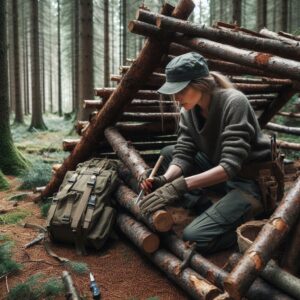 You’ve got your water sorted, but now you need a place to crash. And no, lying under the stars isn’t a viable option unless you enjoy being eaten alive by mosquitoes and other creepy crawlies that have likely been training for this moment since the dawn of time. Seriously, if you wanted a nightly buffet for insects, you could have just stayed home and set out a bowl of peanut butter.
You’ve got your water sorted, but now you need a place to crash. And no, lying under the stars isn’t a viable option unless you enjoy being eaten alive by mosquitoes and other creepy crawlies that have likely been training for this moment since the dawn of time. Seriously, if you wanted a nightly buffet for insects, you could have just stayed home and set out a bowl of peanut butter.
So, let’s talk about choosing your spot wisely. You want flat ground—think of it as picking the right table at a restaurant; nobody wants to eat on an incline unless they’re feeling adventurous with their spaghetti. Stay away from water sources too; waking up floating like some sort of human raft is not the adventure you signed up for. Plus, who needs to be greeted by fish first thing in the morning? They’re not exactly known for their conversational skills.
And let’s not forget about avoiding areas that scream “animal highway.” If there are tracks that look like they belong in a wildlife documentary, it’s probably best to find another location. Unless you’re keen on sharing your sleeping bag with whatever creature decides it’s snack time at 3 AM.
Now onto simple shelter options: if you’ve got a tarp—congratulations! You’re practically glamping now. Just throw down that fancy piece of plastic and call it good. If not, well, get ready to channel your inner MacGyver with branches and leaves. It’s like arts and crafts camp but with higher stakes—namely your comfort and safety.
When building your shelter, aim for something sturdy enough to keep out rain while also ensuring it doesn’t look like it’ll collapse on you mid-snooze. Nothing says “fun camping trip” quite like waking up because your roof decided to take an unexpected dive into your face. So tie those knots tightly! Remember: if it looks like a toddler built it during nap time, you might want to rethink your design choices.
And hey, don’t forget ventilation! You want fresh air circulating so you don’t wake up smelling like last week’s gym socks mixed with wet dog—a scent no one should ever aspire to achieve in nature or otherwise. So go ahead and build yourself a cozy little nest where dreams can happen… or at least where nightmares about giant mosquitoes can unfold safely away from harm’s way!
3. Fire-Making: Channel Your Inner Caveman
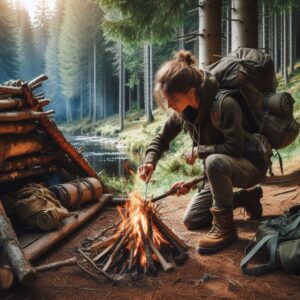 Nothing says “I’m surviving” quite like making a fire. Seriously, it’s the ultimate badge of honor in the wilderness. It’s not just for warmth and cooking up that questionable-looking squirrel you caught; it also sends out a universal signal: “Don’t mess with me, I’ve got this.” Think of it as your personal neon sign flashing “Survivor: Camp Edition!” Plus, let’s be real—nothing keeps wildlife from getting too cozy with you at night like a roaring inferno. Bears may love picnics, but they don’t want to crash your bonfire.
Nothing says “I’m surviving” quite like making a fire. Seriously, it’s the ultimate badge of honor in the wilderness. It’s not just for warmth and cooking up that questionable-looking squirrel you caught; it also sends out a universal signal: “Don’t mess with me, I’ve got this.” Think of it as your personal neon sign flashing “Survivor: Camp Edition!” Plus, let’s be real—nothing keeps wildlife from getting too cozy with you at night like a roaring inferno. Bears may love picnics, but they don’t want to crash your bonfire.
Now, let’s break down the basics of fire-making. You need tinder (and no, not the app where people swipe right on potential dates while sitting in their pajamas). We’re talking about dry leaves, bark, or anything that’ll catch a spark faster than your buddy when he hears there’s pizza nearby. Next comes kindling—those small sticks that look like they might have been rejected by larger branches for being too scrawny—and finally, fuel. That’s right: bigger sticks that are ready to party and keep your flames alive longer than most relationships.
Arrange all these elements like you’re setting up for some kind of rustic campfire concert. Picture yourself channeling your inner caveman—just try not to grunt too loudly unless you want to scare off any friendly woodland creatures who might otherwise join you for a sing-along.
Now onto starting the fire: Matches are great if you remembered them—or if you happen to be one of those organized souls who actually prepares for an outdoor adventure instead of winging it like a contestant on a survival show. A lighter? Even better! But if you’re one of those brave souls who decided matches were too mainstream and forgot both options (because who needs fire-starting tools in the wild?), welcome to the old-fashioned method: friction!
4. Foraging: Because Hunger is the Worst Motivator
 Alright, gather ’round, folks. Let’s talk about foraging in the wild—because, believe it or not, your stomach isn’t a fan of surviving on air alone. I know, shocking revelation. Your gut might be screaming for a five-course meal at this point, but Mother Nature doesn’t quite have an all-you-can-eat buffet just lying around.
Alright, gather ’round, folks. Let’s talk about foraging in the wild—because, believe it or not, your stomach isn’t a fan of surviving on air alone. I know, shocking revelation. Your gut might be screaming for a five-course meal at this point, but Mother Nature doesn’t quite have an all-you-can-eat buffet just lying around.
Foraging is essentially the art of finding edible stuff out there in the wilderness. Think of it as nature’s version of a scavenger hunt, except instead of plastic Easter eggs filled with candy, you’re looking for berries and nuts that won’t send you to an early grave. It’s kind of like playing Russian roulette with nature—only you’re betting your taste buds and gastrointestinal tract instead of money.
So what should you look for? Berries and nuts are usually safe bets—as long as you can positively identify them. And by “positively identify,” I don’t mean squinting at them and thinking they kinda look like something you saw in a survival guide once upon a time. No, I’m talking about having actual knowledge or at least having Googled it before your phone battery decided to join the ranks of extinct species.
Now let’s discuss what to avoid: Anything that looks suspiciously bright, shiny, or weird. If it looks like it belongs in a Tim Burton movie set—or worse yet, if it seems like it could start singing “This Is Halloween” any second—leave it alone. Seriously, nature isn’t trying to win an Oscar here; those eye-catching colors often scream “danger” louder than your mom when she found out about that tattoo.
Mushrooms deserve their own special mention because these fungi are trickier than trying to fold a fitted sheet. One wrong bite into the wrong mushroom and congratulations—you’ve just earned yourself either an express ticket out of this mortal coil or at least a psychedelic trip through Wonderland without Alice as your guide.
So remember: When in doubt—and trust me, doubt will become your constant companion—stick to what you know or can safely verify. After all, no one wants their last words to be “I think this might be edible.”
5. Navigating: Because Getting Lost Is Only Fun for the First Hour
 Alright, let’s get real about getting lost in the wild. Sure, it sounds like the start of an epic adventure movie—cue dramatic music and sweeping drone shots—but trust me, in reality, it’s just a fast track to starving, dehydrating, and generally having a spectacularly miserable time. Think less “Indiana Jones” and more “Where did I put my sanity?”
Alright, let’s get real about getting lost in the wild. Sure, it sounds like the start of an epic adventure movie—cue dramatic music and sweeping drone shots—but trust me, in reality, it’s just a fast track to starving, dehydrating, and generally having a spectacularly miserable time. Think less “Indiana Jones” and more “Where did I put my sanity?”
So you’re out there with nothing but your wits—or lack thereof—and maybe some outdated survival tips you half-remember from that one episode of Bear Grylls. First up: old-school navigation. If you’ve got a map and compass and actually know how to use them (big if), congratulations! You’re already ahead of 90% of us who think GPS stands for “Generally Pretty Stupid.” Align that map like it’s a game of Tetris, find your bearings without looking like a confused pigeon, and off you go.
But what if you don’t know how to use them? Well then, my friend, you’d better start cozying up to moss. Yep, moss—the unsung hero of plant life—because apparently it grows on the north side of trees… most of the time. It’s not exactly Google Maps with turn-by-turn directions, but hey, beggars can’t be choosers.
Now let’s talk natural navigation for when all else fails—which is often because Mother Nature has a twisted sense of humor. Here’s the deal: Find a stream and follow it downhill. Water usually leads to civilization or at least something resembling it—a road perhaps. And roads are basically nature’s way of saying, “Humans were here.” They’re like breadcrumb trails left by society so you can stumble back into Wi-Fi range.
So remember: Getting lost might sound poetic in theory but trust me—it’s mostly just sweaty panic attacks interspersed with bouts of questioning every life choice that led you there. Stick to what you know or at least pretend convincingly enough until help arrives.
6. Staying Calm: The Art of Not Losing Your Shit
Alright, let’s be honest here—the wild can be downright terrifying. I mean, the noises alone are enough to make you question every horror movie you’ve ever watched. And the isolation? Yeah, it’s not quite the peaceful solitude poets rave about. It’s more like being the last snack pack in a vending machine full of predators. You’re basically nature’s version of fast food.
But here’s the kicker: panicking is about as useful as a screen door on a submarine. It gets you nowhere fast and just makes everything worse. So what do you do instead? Mind over matter, my friend.
First things first: breathe. Seriously, just take a moment to suck in some oxygen and remind yourself that freaking out never helped anyone except maybe reality TV producers. Then think—yes, actually use that brain of yours before making any rash decisions like trying to befriend a bear or building a shelter out of poison ivy.
The wild has this funny way of rewarding patience and punishing stupidity with extreme prejudice. Think of it like dealing with your in-laws: stay calm, don’t say anything dumb, and you’ll probably survive.
Next up: stay focused. Set small goals for yourself—manageable ones that won’t end with you starring in an episode of “Unsolved Mysteries.” Start with “find water.” Water is crucial unless you’re planning on setting new records for dry mouth.
Once you’ve got hydration sorted, move on to “build shelter.” You want something that’ll keep you safe from the elements and whatever critters might see you as their next Airbnb guest.
And finally, the big one: “don’t die.” It sounds obvious, but sometimes it’s good to remind yourself of the basics when you’re surrounded by trees that all look suspiciously alike.
So there you have it—one step at a time and you’ll make it out with all your parts still attached (and hopefully no new phobias). The wilderness might be scary, but remember: it’s just another challenge waiting for you to conquer—or at least survive long enough to tell everyone how brave you were later!
7. Signaling for Help: When You’ve Had Enough of Playing Robinson Crusoe
 Hey, there’s absolutely no shame in admitting that you want out. Whether you’re on day one of your wilderness adventure or day 101, sometimes you just need to swallow your pride and call in the cavalry. After all, even Bear Grylls probably has a hotline to civilization.
Hey, there’s absolutely no shame in admitting that you want out. Whether you’re on day one of your wilderness adventure or day 101, sometimes you just need to swallow your pride and call in the cavalry. After all, even Bear Grylls probably has a hotline to civilization.
So, how do you signal for help when you’ve had enough of playing Survivor: Real Life Edition?
First up: fire. Three smoke signals are the universal distress call. Think of it as nature’s way of texting “SOS” to the universe. It’s like sending up three big, smoky flares that scream, “Hey! Over here! I’m done pretending I can live off berries and questionable water sources!” Just make sure not to accidentally start a forest fire; you don’t want your rescue mission turning into an episode of Smokey Bear’s worst nightmares.
Next on the list: mirrors and shiny objects. Flashing light at passing planes or boats is a classic move straight out of the survivalist playbook. Who knew that carrying a compact mirror could be such a lifesaver? And no, it’s not just for checking if you still look good after days without proper hygiene (spoiler alert: you probably don’t).
Imagine this: you’re standing there, desperately waving your mirror around like you’re trying to catch the attention of someone across a crowded room at a concert—except instead of meeting new friends, you’re hoping for a rescue chopper. It’s basically Tinder for survival situations but with less swiping and more flashing (the legal kind).
So remember, whether it’s day one or day 101, knowing how to signal for help can turn your wilderness nightmare back into the cozy reality where takeout is just a phone call away. And let’s face it—sometimes that’s exactly what we all need.
Whistles and loud noises: Three sharp blasts, and someone might hear you. If not, at least you’ll scare away whatever was rustling in the bushes.
In Conclusion – Mastering The Wild
Surviving in the wild isn’t about being the strongest, the smartest, or even the most prepared. It’s more like a game of “Don’t Do Anything Stupid.” Seriously, it’s not about wrestling bears or making fire with two sticks like some kind of prehistoric magician. It’s about using that often elusive trait we call common sense.
First off, staying calm is key. Picture this: you’re lost in the middle of nowhere, and your brain starts doing its best impression of a hyperactive squirrel on caffeine. Panicking gets you nowhere fast—except maybe deeper into trouble. So take a deep breath, channel your inner Zen master, and remember that freaking out never helped anyone find their way back to civilization.
Next up, let’s talk about knowing when to call it quits. There’s no shame in waving the white flag and admitting you need help. In fact, it takes guts to admit you can’t do everything alone—kind of like asking for directions when you’re hopelessly lost (which none of us ever do because GPS exists… until your phone dies).
And then there’s common sense—a survival tool as underrated as wearing sunscreen at the beach. Don’t eat anything brightly colored unless you’re sure it’s food and not nature’s version of a neon sign saying “Danger!” And if something seems like a bad idea—like trying to cross that raging river without a bridge—it probably is.
So remember: surviving isn’t about heroics; it’s about keeping your wits about you and avoiding stupid mistakes. With these essential skills, you might just make it out alive—or at least with one heck of a story to tell at parties. After all, who doesn’t want to hear how you bravely navigated the wilderness armed with nothing but sheer willpower and questionable decisions?

